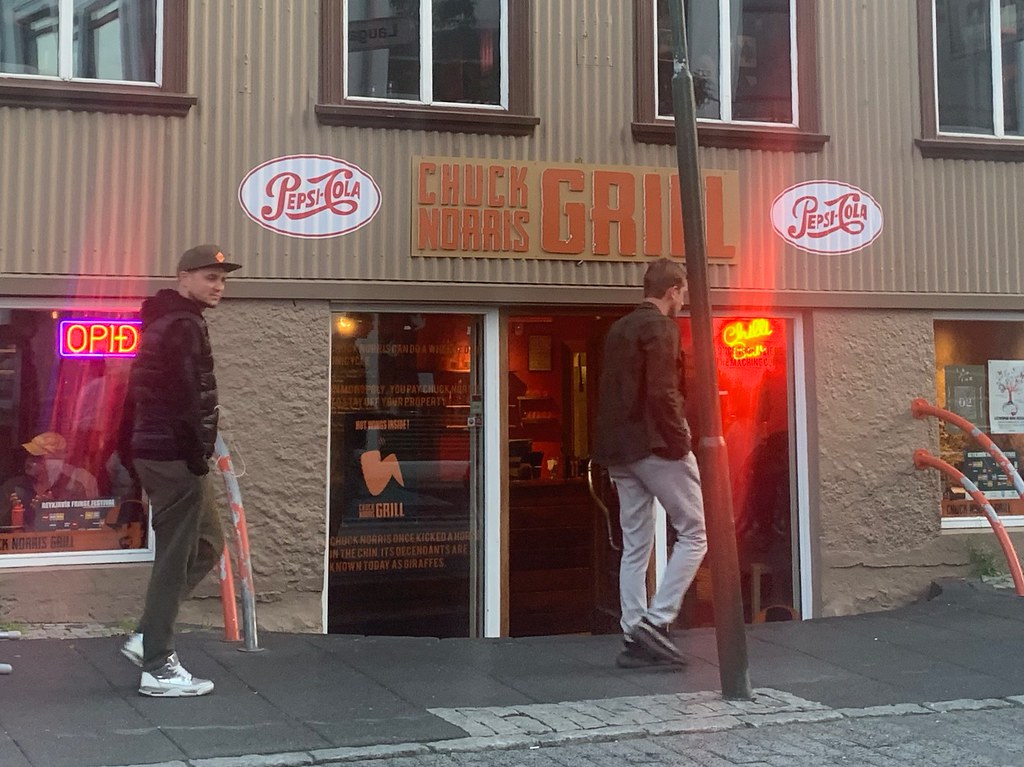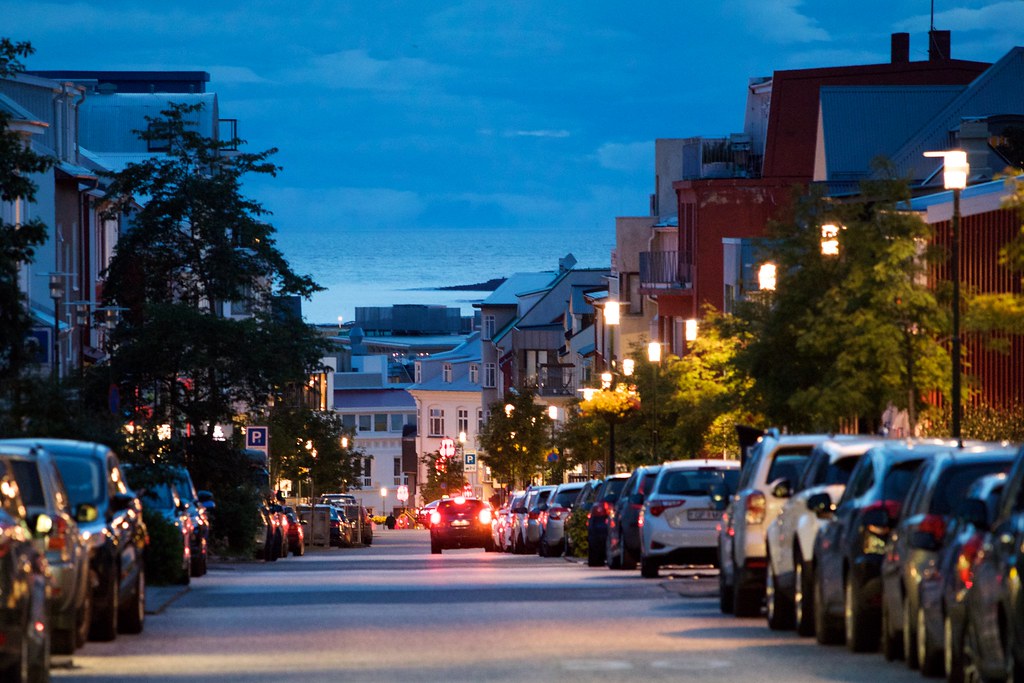Staycation in Reykjavik
If it wasn’t clear to me already from riding through the towns on the outskirts of Reykjavik, it would be clear now: The capital city is a different world.
It’s mostly cement and steel, but to my eye, it sometimes looks like a little toy lego version of a city. In fact, I think the relationship goes both ways: If a child was given a heap of legos and told to build a city, they would probably create something that looks suspiciously like Reykjavik to an Icelander.
Now that I was established in my room, I reconfigured my bike for around-town touring and set off in search of food. I didn’t have hard data but I was sure I’d burned a ludicrous amount of calories getting here, and it was time to eat, sort photos, and catch up on work.
I put on my pants and Hawaiian tourist shirt – to be like Twoflower – and rode downtown to the trendy tourist area. Well, the area that was even more touristy than the rest of the city. For the first time since arriving in Iceland I entered an actual crowd. The bike got the usual distracted stares of course. I planned to spend many hours on the laptop so my destination was a cafe that claimed to be open late, and when I arrived I found a bike rack only 20 meters away, which pleased me. I can get right to work! Great to be in the city!
The cafe served sandwiches, cake, and various kinds of coffee. So I got one of each. Again the price was only slightly less than what I would have paid in San Francisco. Appalling to the tourists, just another day for me.
I was very pleased to see a crafty science fiction reference decorating the walls.
The cafe turned out to be a great place to hang out, and just like the cafe in Keflavik, I decided I would go there regularly. I know it seems stupid for a person visiting a huge city for a limited time to spend more than one day in the same place, but routine is an important part of my well-being, and the theme of my journey – the thesis if you will – is that it’s just as valuable to spend a lot of time absorbing the detail of one place, as it is to get a surface impression of many places. Perhaps even more valuable.
I had other options of course. The Big Lebowski Bar and the Chuck Norris Grill, to name two.
Yeah, I ain’t kidding! These are real places, and very self-aware.
Along with the photos and the work, I also answered some more curious questions from friends:
Right now my best summary is, three years of Trump have not displaced three generations of slow immersion in American pop culture, and money, and military presence, with both good and bad influences.
A little bit of history here to set the stage.
Iceland was mostly populated by subsistence farmers and fishermen, of varying cultural origins, for many centuries. After World War II that all changed, and the US had a heavy hand in directing those changes, giving a big chunk of money to Iceland through the Marshall Plan and establishing a military base there as part of NATO. Iceland leapt forward and despite being the most sparsely populated country in Europe, also became one of the wealthiest and most modern.
The money was welcomed, the military protection grudgingly accepted, but Americans personally were not. Almost all the contention was over American soldiers mixing with Icelandic women. Soldiers were given curfews, women were put in jail, et cetera. The view back from the present is not a kind one: Icelanders said they were protecting culture, but what they were doing was policing their daughters. Just another case of men trying to control women for the sake of their bloodline.
Modern concerns about Icelandic culture are much more thoughtful and empathetic. It’s not about controlling women’s bodies, it’s directly about preserving history, attitudes, and the land itself. And these concerns are valid: Over the span of 70 years and two or three generations, the attitude towards Americans gradually shifted and the cultural influence of films, books, and most especially music emanating from the military base radio station has slowly but inexorably permeated Iceland and extinguished a lot of traditions. Plus, Iceland integrated very tightly with the world economy, and the American economy especially. The economic crash of 2008 was devastating for Icelanders, and a lot of their recovery has been centered around tourism, which is a further threat to their individuality.
(As an aside, the military base was shuttered in in 2006, and Iceland now has no standing army of its own.)
So, how does this translate to the reception of Americans on the ground?
Like anywhere, it’s a love and hate thing. People from politically liberal or affluent families in the US make good tourists of Iceland, and are well received. Their instincts are similar. Those who show up and are loud, crass, ignorant, and messy, because that’s how they are back home, are thoroughly disliked.
For example: I came downstairs from my hotel room, on my second day in Iceland, to ride my freshly assembled bike around town and I passed by the bar area in the hotel lobby. There were eight or nine American servicemen there getting drunk and talking crap to each other in loud voices. One of them took a drink and bellowed: “Okay guys here’s a question, how many of you would fuck a midget?”
His shouted question got a pile of shouted responses from his friends, all of them just as crass and stupid as you can imagine.
The woman behind the desk who had been so pleasant to me in our interactions over the past few days had a look on her face like, “I wish all of these people would catch fire and die.” And I felt exactly the same way. I wanted to make some comment like, “on behalf of Americans, I apologize for those jerks over there,” but she was less than 15 feet away from them and I didn’t want them to overhear it and punish her. So I just hoped I was a counterexample.
I’ve been friendly, thankful, and straight-forward, and every one of my conversations has gone well. But of course open conflict over anything is highly discouraged in Icelandic society, so, how would I really know what people think?
To compare wireless coverage for Americans, I think it makes sense to compare Iceland to the state of Idaho, which has several massive mountain ranges threading across it. Iceland has about 40,000 square miles of land area. That’s about half the size of the state of Idaho. Its highest peak is Hvannadalshnjúkur, about half the height of Borah Peak in Idaho. It has about 330,000 people in it. That’s less than one fifth of the population of Idaho. The land mass of Iceland has 95% wireless coverage. In Idaho, two competing cell networks give Idaho about 85% land coverage, reaching 99.4% of the population. So, in real terms, it’s about the same.











